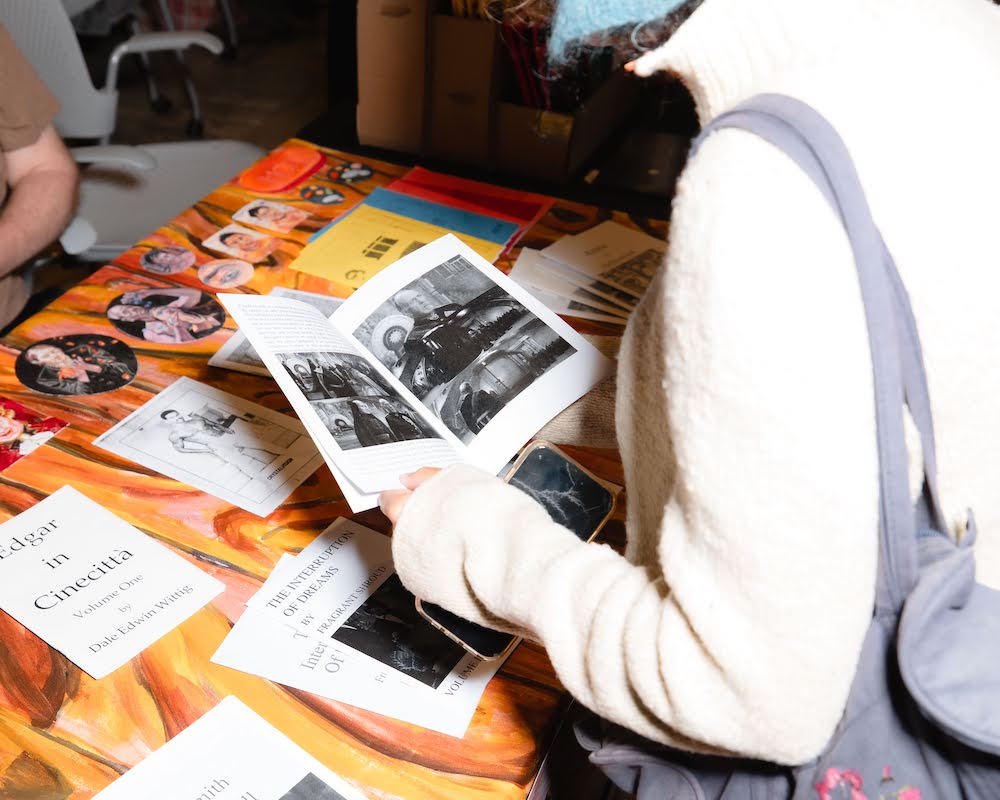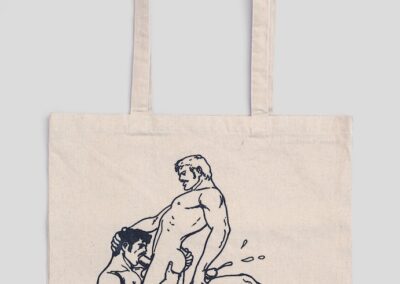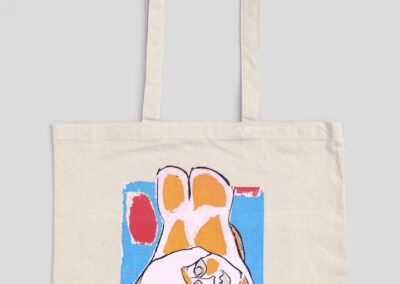Our reporter on the ground works her way through this year’s labyrinthine fair with the help of its most visible symbol: The tote bag.
The Printed Matter Art Book Fair goes high and low, and tote bags are its connective tissue. The fair provides a platform for established and emerging independent publishers, scrappy DIY zine makers, and vintage booksellers peddling archival objects. The tote bag unifies these demographics.
Since its first iteration in 2013, the Los Angeles Art Book Fair has been staged at Geffen MOCA. 2025 saw LAABF’s maiden voyage to Art Center College, where it sprawled across multiple buildings, with programming tucked into classrooms and corridors. The cartography of the LAABF is almost illegible. As an event, it overwhelms, a total phantasmagoria with no apparent center. Yes, there were directional signs, but the fair cannot be read front to back. Visitors must develop individual strategies to find their way.
The strategy I propose? Tote bags. Tote bags are everywhere at the fair. They are useful for taxiing around one’s book haul, but they represent so much more. The bags are art objects, signifiers of waste consciousness, and brands of themselves. They embody the artist’s need to diversify his revenue streams through sidelines. LAABF is the tote bag’s ground zero, and I took it tote by tote.
The Barbara Kruger Tote

An ample black bag with a high contrast graphic depicting a close-cropped sAn ample black bag with a high contrast graphic depicting a close-cropped set of canine fangs with a slash of Kruger’s signature Futura text boasting “Business As Usual.” It seemed appropriate that it’s displayed in a place of prominence at the Printed Matter booth, an apparent masthead of the fair. It embodied the fundamental currents of Printed Matter: The distribution of archival fine art effluvia and the transmission of art objects through non-traditional venues.
Printed Matter’s founders were rooted in post-conceptualism, circulating artists’ books as an alternative to participation in the mainstream gallery system. This self-publishing impulse coincided with Mail Art and suited serial photo projects. Think Ed Ruscha’s books of California parking lots, or Eleanor Antin’s documents of 100 boots arranged across diverse geographic backdrops. This indexical strain is alive among the younger generations. Its influence can be seen in recent publications by Brendan Donnelly, Carolina Hicks, Alicia’s Klassic Kool Shoppe and Jessalyn Aaland, all of whom produce books of found objects. Their nostalgic packaging, stickers, and collections of matchbooks and QSL radio cards, all arranged in clean collages, are tidy archives of consumption.
The Kruger tote would be at home slung over a shoulder at a blue-chip gallery opening or in the freezer section of Trader Joe’s. Kruger’s style occupies the strange space of having been co-opted by a streetwear brand while maintaining its own supremacy. The tote’s ability to shape shift across multiple contexts—and the artist’s ability to merchandise multiples—is business as usual.
The Semiotext(e) Tote
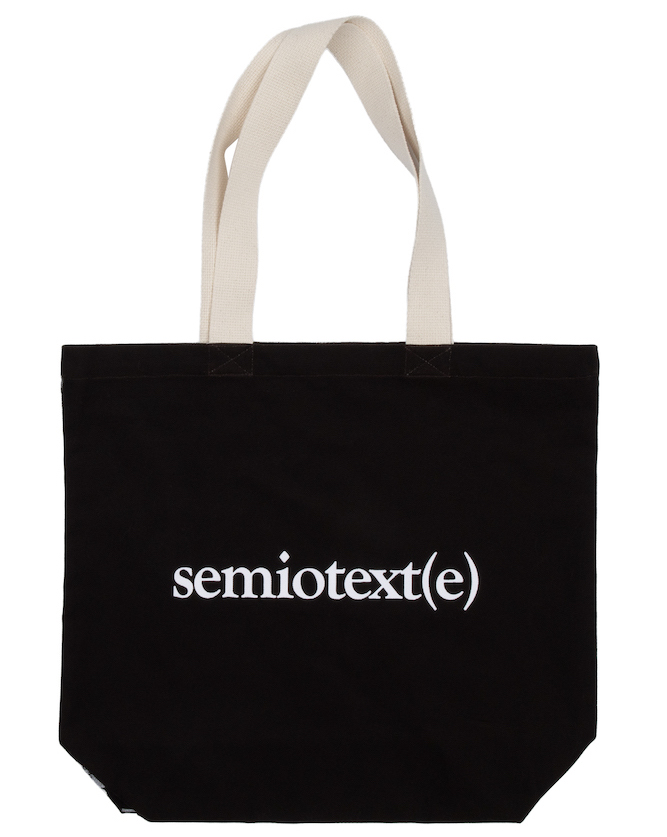
Courtesy of Semiotext(e)
Unadorned black totes bearing the publisher’s name in unadorned typewriter font. Semiotext(e) embodies the old guard of independent, art-book publishers. The work published by Semiotext(e) is spiritually interwoven with the Printed Matter project, having forged their own subversive literary platform with a roster of counterculture luminaries and continental philosophers whose influence is evident in the Cookie Mueller chapbooks and the slim volumes on heavy topics contained by their Intervention Series: The Invisible Committee, Jackie Wang and more. But with complicated distribution deals and an unsympathetic regime at the helm of public arts funding, small publishers have to scramble to make up the difference, sometimes throwing tote bags in the air as a distress signal. At the fair on Friday, a series of crop tops depicting the French critical theorist, George Bataille—and yes, black totes bearing the Semiotext(e)—were displayed behind the booth. Editor Chris Kraus confided that Semiotext(e)’s NEA grant was rescinded this year, but that, “Even before the NEA grant was rescinded, we’d planned to add t-shirts and tote bags to help cover [increased overhead] costs.” I deeply regret not buying a crop top if anyone has an extra.
The Fake New Yorker Tote
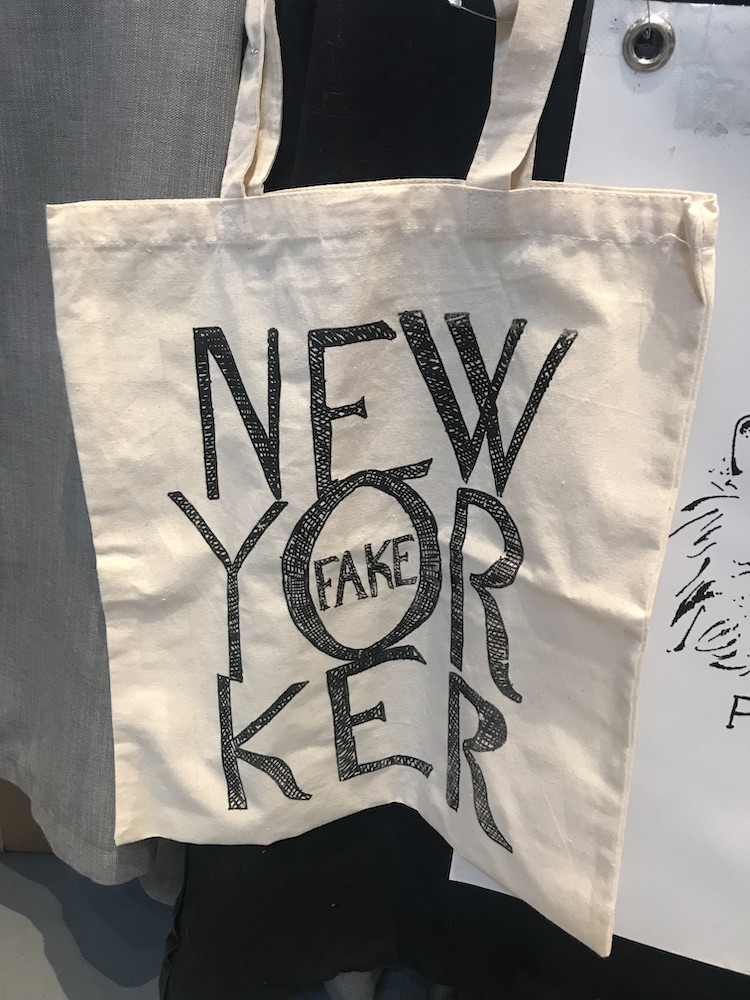
An enviable anti-design, the Sybil Press Fake New Yorker tote represents the DIY, punk ethos of the last standing zinesters still stalking the LAABF. It’s a provisional version of the understated official logo, and it looks like a sixth grader drew it with a Sharpie stolen from a Kinko’s self-service kiosk: cross-hatched letters scrawled across an off white bag.
Participation in the Printed Matter fair isn’t cheap. Exhibitors in the zine pavilion pay $175+ to occupy a four-foot folding table for the duration of four days. A punk has to keep expenses low with stolen Sharpies and saddle staplers, making copies on the clock at office gigs. The Fake New Yorker tote saves legwork by appropriating an existing design and broadcasting its oppositional relationship to that institution, gleefully embodying punk itself. Several issues of Fake New Yorker Magazine by the artist Carrie Rennolds populated the Sybil Press table. Calculatedly naive and hand-drawn in black on white pages, it retailed for $12. The tote was $20.
The David Kordansky Gallery Tote
-

Tom of Finland Tote. Photo: Jeff McLane. Courtesy of David Kordansky Gallery.
-

Ruby Neri Tote. Photo: Jeff McLane. Courtesy of David Kordansky Gallery.
Starting Thursday, rumors circulated that this year’s David Kordansky design was “spicy.” When the tote finally made it onto the wall behind their booth, I was not disappointed. Two spicy totes appeared: One featured a Ruby Neri image of a woman with a beatific grin brandishing her blobby orange ass, and the other was an archetypal Tom of Finland design—chiseled beefcakes giving head, which begs for a great farmers market haul. The Kordansky totes represented the high-end galleries who lined the main floor of the 950 Building, publishing glossy artist monographs—massive, high-end books meant for ten-thousand-dollar coffee tables that make booksellers’ sciatic nerves squeal.
Blue-chip galleries need merch, too. The economic realities of the art market are bleak, as evidenced by quarterly losses coming out of the 2024 Frieze Fair . High-end art sales can be money laundering screens at best. But booksellers can fall back on totes as hard assets, if only for the fact that they probably have piles of them at their houses from previous fairs.
My Own Tote Bag
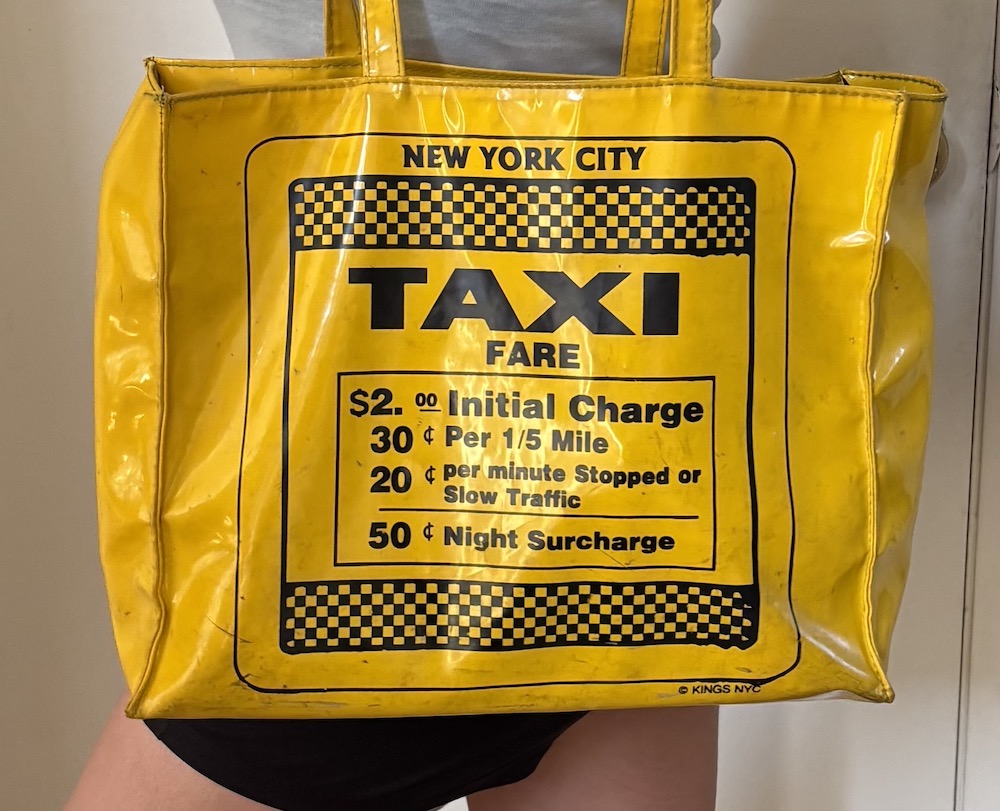
My own tote bag, a yellow vinyl novelty tote, ripped from 1980s Times Square and silk screened with the era’s taxi fares is the only tote bag that exceeds its symbolic, graphic exterior by virtue of the fact that…well, I know what is inside it. My tote bag represents my reprieve from the hyperlapse of the fair’s frantic externalities, into what the fair is all about: the books themselves. My own tote bag correlates to perhaps my favorite room of the fair, a Reading Room on the ground floor of 870, a reprieve from the masses into the pleasure of books, with installations acknowledging who isn’t here.
The Reading Room featured an installation I flipped through quietly as the Sunday melee died down. A book of bound paper scraps with deckled edges tethered to the wall contains scans of visa result documents from China–stamped, approved, or under review—submitted by two artists who were unable to make the journey to LAABF due to repressive immigration policies.
Tote bags can make a journey that other art objects and individuals can’t. These oversized pockets printed with artists’ images transport and occlude, broadcast and smuggle. Their ubiquity straddles publics. Like the fair itself, this final installation points to the difficulty of navigation, but the faith—which sustains all us true believers—that printed matter can transgress borders.

